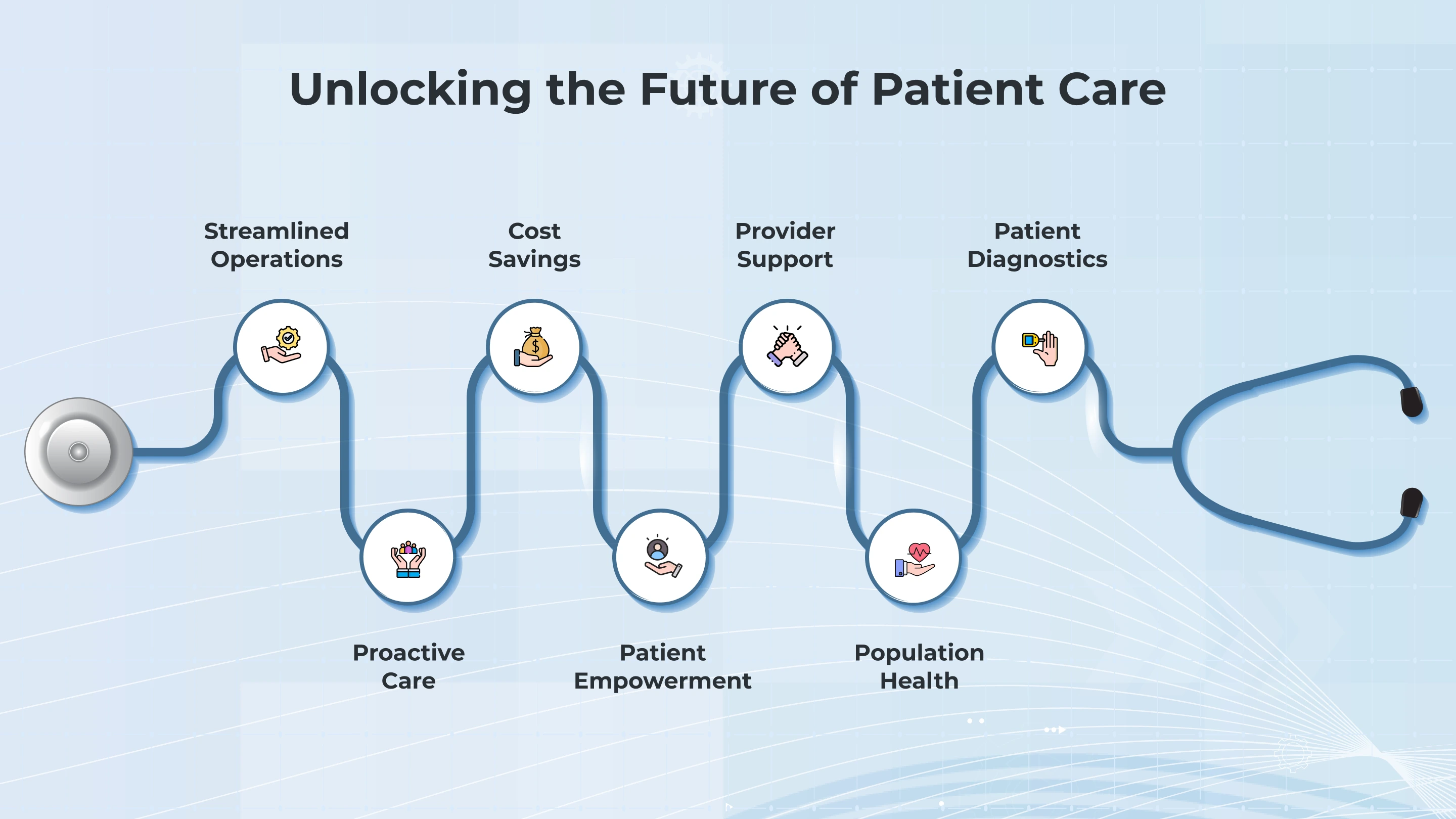
Unlocking the Future of Patient Care: The Power of Technology Integration
Where should we begin on the journey toward transforming patient care? Generally, people are aware of patient portals, mobile prescriptions, and perhaps even the latest generation of imaging diagnostics. However, these are just the beginning of what healthcare technology can do. In fact, the potential of technology to change lives and improve the patient care experience is substantial. Technology integration in healthcare plays a pivotal role in this process, connecting various systems, streamlining workflows, and enabling seamless data sharing, which enhances the overall quality of care.
Redefining Patient Care with Technology Integration
Technology integration in healthcare has the potential to completely transform how we give and receive care. To create innovative solutions that improve patient outcomes, increase productivity, and promote seamless communication across the healthcare system, healthcare software development is critical. Let’s look at how these advancements lead to a healthier future and better patient care:
- Imagine the impact of early cancer detection—identifying stage-one cancer cells when they are still highly treatable.
- Consider a patient with a chronic disease who has glucose or blood pressure monitor to alert them to a potentially life-threatening issue before it escalates and sends them to the hospital, or worst case, they perish.
- Give physicians a comprehensive picture of their patients’ health by providing access to all the resources they need through a single platform that seamlessly integrates medical records, test results, and diagnostic insights.
- Empower clinicians to make faster, better-informed decisions; this degree of technology integration redefines the standard of care and saves lives.
Why are MedTech Integrations So Important?
Traditional healthcare faces many challenges, from data that is highly fragmented to systemic inefficiencies with administrative workflows, communication interruptions, scheduling, reactive vs. preventative care, supply chain, and workforce burnout, to name just a few. These hinder the delivery of high-quality, timely, and cost-effective care. MedTech Integrations address these and many more inefficiencies.
Automating processes, providing real-time insights, and enabling interoperability help to create an efficient, connected, patient-centered, sustainable system. Key benefits include:
-
Streamlined Operations
Automation and interoperability reduce manual paperwork with tools like automated billing, digital scheduling, and e-prescriptions.
-
Patient-Centered Diagnostics and Treatment
Real-time access to data and AI-driven tools to improve accuracy and reduce delays in starting treatment.
-
Proactive Care
Optimizing tools, data integrations, and predictive analytics using RPM (Remote Patient Monitoring), which helps identify and treat issues quickly.
-
Cost Savings
Reducing waste from system redundancies by sharing data across health systems and optimizing the supply chain with inventory tracking ensures resources are used wisely.
-
Patient Empowerment
Connected devices and apps enable and engage patients in managing their health.
-
Provider Support
Workflows are an organization’s lifeblood; improving them with enhanced automation reduces clinician burnout and time.
-
Population Health
So much data is collected nowadays, and it needs to be used to help patients and the community.

Significant Technology Integrations to Improve Patient Care
1. AI-driven diagnostics and Imaging
Are in their infancy. Still, two cases showcase how AI can enhance diagnostic accuracy and speed, ultimately improve patient care and support healthcare professionals in their decision-making process.Two examples of how AI-driven diagnostics are making an impact:
- Overview: Google Health has built an advanced AI model for accurately detecting breast cancer in mammograms. In this model they Google used extensive collection of mammogram images to find patterns associated with cancerous tissues.
- Impact: In clinical evaluations, this AI system performed well when compared human radiologists in both sensitivity (accurately identifying cancer) and specificity (reducing false positives). It also reduced radiologists’ workloads by determining cases that require more examination, thereby enhancing overall diagnostic efficiency.
- Overview: Zebra Medical Vision provides AI-powered tools for analyzing medical imaging data (such as CT scans, MRIs, and X-rays). The company’s platform is designed to detect various diseases, including cardiovascular issues, lung diseases, and cancers.
- Impact: Zebra’s AI algorithms have been integrated into several healthcare systems to assist radiologists in diagnosing and prioritizing cases. Its technology helps detect abnormalities in medical images more quickly and accurately, leading to earlier diagnosis and better patient outcomes.
2. IoMT, RPM and Wearables
Improve care by enabling continuous monitoring and timely interventions with hyper-personal care. Here is the summary of a case that shows the promise of these technologies: the Dexcom Continuous Glucose Monitoring (CGM) System with Remote Patient Monitoring (RPM) has an impact on care which includes:
- Better Management of Diabetes: Patients can reduce the risk of harmful glucose spikes or drops by immediately modifying their diet, exercise, or insulin use by monitoring their blood sugar levels in real-time.
- Early Intervention: By setting up alerts for abnormal glucose levels, healthcare professionals can take action before a patient has a crisis (such as hypoglycemia or hyperglycemia), which lowers the number of hospitalizations and emergencies.
- Improved Patient Engagement: With continuous access to their health information and remote assistance from their care team, patients feel more capable of managing their condition.
IoMT has many benefits, but one that will have a significant impact is reduced hospital visits. By facilitating proactive, ongoing, and remote care, IoMT holds promise for improving the management of medical conditions outside of conventional clinical settings. One important finding is that IoMT improves patient outcomes, lowers hospital admissions, and eases the strain on healthcare systems by transforming care from reactive to proactive. healthcare systems.
3. Remote Patient Monitoring
Is fast becoming a necessary tool for managing chronic illness. AI is being used to detect health problems like heart attacks early so that medical professionals can take action before things get worse. The main advantages are:
- Preventative care and customized alerts
- Integration of Telemedicine After Surgery and After Discharge
- Improved Adherence and Patient Engagement
- Improved Care of the Elderly and Vulnerable Groups
The Future is Bright and Connected
AI in healthcare is poised to energize into a proactive and not reactive ecosystem, offering transformative benefits across the industry. Many of the benefits will include technological improvements from enhancing interoperability and securing health data to advancing diagnostics and streamlining administrative tasks and workflows, AI and all of the MedTech integrations have the potential to create a seamlessly connected healthcare ecosystem. By optimizing efficiency and reducing operational burdens, AI focuses on delivering high-quality patient care while improving overall system performance.
Patient-centered is a big challenge, but if we succeed with this, many areas of in the healthcare sector benefit. Improved access, ongoing coordination, and individualized care are the foundations of a patient-centered healthcare ecosystem. Customized therapies, early detection, and interventions, as well as better patient outcomes and fewer hospitalizations, can all be made possible by AI-driven insights. While lowering errors and duplications, interoperable patient health records contribute to coordinated care. Meanwhile, there are many benefits for empowering patients to use telehealth and remote monitoring with real-time insights and stronger provider connections, to foster engagement and proactive health management.
It’s Only the Beginning!
We all know that MedTech integration can have a big impact on healthcare, but their success depends on how safe, effective, and efficient they are. In order to enhance patient care and community health, it is critical to promote the growth of these technologies among the many stakeholders in the healthcare ecosystem. Interoperability is facilitated by technology integration, and data security plays a key role in this development by guaranteeing that health information is safe and available.
As the industry advances, healthcare technology providers must make a priority robust safeguards while enabling seamless data exchange to build a more connected, secure, and patient-centric healthcare system. This is just the beginning of a transformative journey, with countless opportunities to unlock value.






































